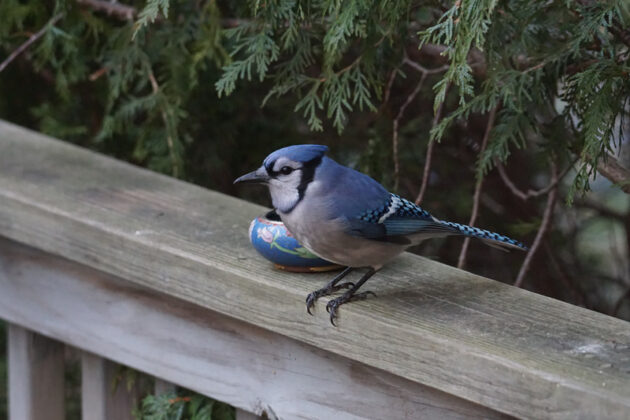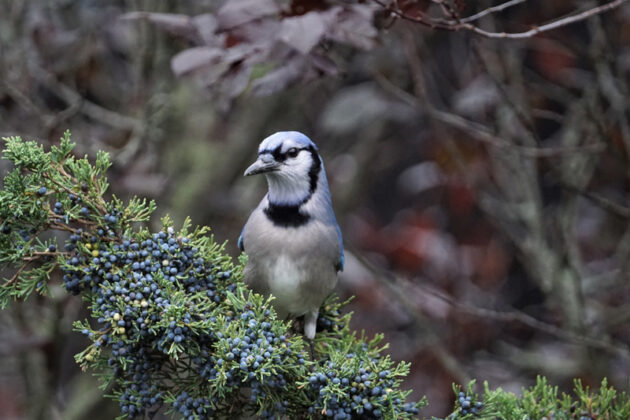For various reasons, I’ve stuck pretty close to home this winter, doing most of my naturalizing in or near our tiny yard in Oak Bluffs. This is not to complain: Like Henry David Thoreau, who famously “traveled extensively in Concord,” I find that studying our scant quarter-acre is endlessly fruitful. Among the local pleasures of the past few months has been a renewed appreciation of one of our most common and familiar birds, the blue jay.
I chose the word “appreciate” carefully. I’m afraid I can’t say I like this species: Blue jays are not amiable birds, and while I try to avoid letting human values influence how I view the natural world, the aggressiveness, greed, and indiscriminate, predatory habits of this species make it a hard one for me to feel fond of. But blue jays are fascinating birds to watch, intelligent, resourceful, and social, and I admire their spunky versatility.
They’re also beautiful, one of those overly familiar bird species that we’d go gaga over if they were rare. Just shy of a foot in length, a blue jay (males, females, and fledged young all look pretty much alike) are sky-blue above, white on the belly, and faintly gray on the breast. (Most of the blue coloration is said to stem from diffraction of light by the structure of the feather, not from pigment.) Tail feathers, wing coverts, and flight feathers on the inner part of the wing are checkerboarded with black; a thin black ring circles the nape and throat. The black bill is prominent and robust, and a pointed crest, more erect the more agitated its possessor gets, tops the head.
In flight, blue jays show a fairly long tail, rather short, rounded wings, and gray wing linings. While the species can really scoot when it wants to, blue jay flight tends to be leisurely: Birds idle along, alternating short bursts of flapping and glides. Get your binoculars on a blue jay in flight, and you’ll note that these birds are constantly scanning their surroundings, ever alert for something edible to drop down and grab, or a Cooper’s hawk that needs to be dodged.
The limited birdfeeding program I’ve carried out this winter — a dish of water and a small handful of mixed seed put out once or twice a day — was aimed mostly at attracting sparrows and chickadees. But it hasn’t escaped the attention of the local jays, with as many as a dozen sometimes showing up after I’ve put food out. Their use of this resource has given me a front-row view of the semisocial habits of blue jays in winter.
Often, only a single jay is evident when I put food out. But if so, that jay is clearly working as an observer supporting the whole team. As soon as the food is out and the coast is clear, the sentry summons his buddies with the ringing, eponymous “Jay! Jay!” call of this species. Within moments, every jay in the area has descended. There is a clear hierarchy in the group, with some birds chasing others away from the choicest bits (peanuts!). And the group cooperates to keep other species away from the buffet. But within a few minutes, every member of the flock will have topped up its tank, and the group moves on with what I assume is a regular route. A hallmark of jays and their close relatives the crows, such cooperative foraging is a powerful strategy.
Blue jays are present year-round on the Vineyard, though winter numbers vary considerably. Island Christmas Bird Counts typically run up blue jay tallies in the low hundreds. But the count has yielded as many as 746 blue jays (in 2007) and as few as 24 (in 2016). Traditional belief, supported at least somewhat by research, says that years of poor acorn production tend to prompt southward migration in blue jays, presumably since acorns are a significant source of winter nourishment for these birds. Our breeding population in the summer must surely include hundreds of pairs; this is a plentiful species on the Vineyard, nesting in oak woodland as well as in settled neighborhoods.
While I can’t say for certain, I expect the jays I’ve been watching are local residents staying put for the winter, members of several family groups associating to increase safety and facilitate scouting for food. The species is much less social in the breeding season, with less communal feeding, though local birds will still team up to make life miserable for potential predators like crows, hawks, and cats. During the nesting season, our local jays feed heavily on nestlings and, especially, eggs of other species, while also eating a mix of arthropods, seeds, and fruit. These birds are the quintessential omnivores.
The aggressive blue jay will never be a favorite species of mine. But the satisfaction of getting reacquainted with our jays reminds me that even familiar species reward close observation.





